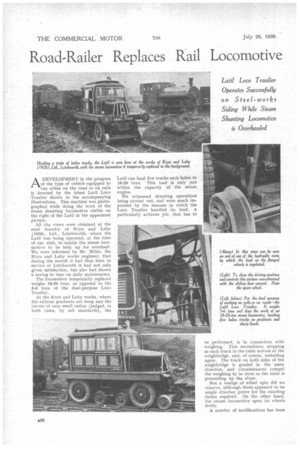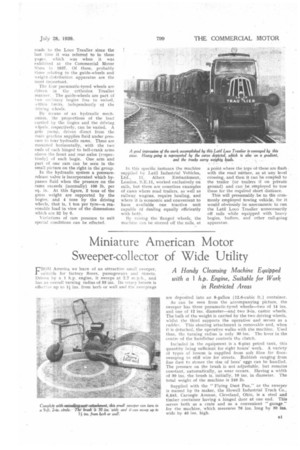Road-Railer Replaces Rail Locomotive
Page 34

Page 35

If you've noticed an error in this article please click here to report it so we can fix it.
Laid Loco Traulier Operates Successfully on Steel-works Siding While Steam Shunting Locomotive is Overhauled
ADEVELOPMENT in the progress of the type of vehicle equipped to run either on the road or on rails is denoted by the latest Latil Loco Traulier shown in the accompanying illustrations. This machine was photographed while doing the work of the steam shunting locomotive visible on the right of the Latil in the uppermost picture.
All the views were obtained at the steel foundry of Kryn and Lahy (1928), Ltd., Letchworth, where. the Latil was being operated, at the time of our visit, to enable the steam locomotive to be held up for overhaul. We were informed by Mr. Miller, the Kryn and Lahy works engineer, that during the month it had then been in service at Letchworth it had not only given satisfaction, but also had shown a saving in time on daily maintenance.
The locomotive temporarily replaced weighs 18-20 tons, as opposed to the 5-6 tons of the dual-purpose Loco Traulier.
At the Kryn and Lahy works, where the railway gradients are steep and the curves of very small radius (judged, in both cases, by rail standards), the Latil can haul five trucks each laden to 16-20 tons. This load is only just within the capacity of the steam engine.
We witnessed shunting operations being carried out, and were much impressed by the manner in which the Loco Traulier handled its load. A particularly arduous job, that has to be performed, is in connection with weighing. This necessitates stopping as each truck in the train arrives at the weighbridge, and, of course, restarting again. The track on both sides of the weighbridge is graded in the same direction, and circumstances compel the weighing to be done as the train is proceeding up the slope.
Not a vestige of wheel spin did we observe, although there appeared to be ample drawbar power for the exacting duties required. On the other band, the steam locomotive spun its wheels freely.
A number of modifications has been
made to the Loco Traulier since the last time it was referred to in -these pages, which was when it was exhibited at the Commercial Motor Shoe. in 1937. Of these, probably those relating to the guide-wheels and weight-distribution apparatus are the most int portant.
The four pneumatic-tyred wheels are driven in the orthodox Traulier Martiwr, The guide-wheels are part of two Inc:Mary bogies free to swivel, within limits, independently of the driving wheels.
By means of an hydraulic mechanism, the proportions of the load carried by the bogies and the driving wire's, respectively, can be varied. A gear pump, driven direct from -the main gearbox supplies fluid under pressure to tour hydraulic rams. These are mounted horizontally, with the two ends of each hinged to bell-crank arms above the front and rear axles (r.-_speclively) of each bogie. One arm and part of one rate can be seen in the small picture on the right in the group.
In the hydraulic system a pressurerelease valve is incorporated which bypasses fluid when the pressure on the rams exceeds (normally) 100 lb. per sq. in. At this figure, 2 tons of the gross weight are supported by the bogies, and 4 tons by the driving wheels, that is, 1 ton per tyre—a reasonable load in view of the dimensions which are 32 by 6.
Variations of ram pressure to suit special conditions can be effected.
In this specific instance the machine supplied by Latil Industrial Vehicles, Ltd., 11, Albert Embankment, London. S.E.11, worked exclusively on rails, but there are countless examples of cases where road trailers, as well as railway wagons, require hauling, and where it is economic and convenient to have available one tractive unit capable of dealing equally efficiently with both.
By raising the 'flanged wheels, the machine can be steered off the rails, at
a point where the tops of these are flush. with the road surface, as at "any level crossing, and then it can be coupled to the trailer .(or trailers if on private ground) and can be .employed to tow these for the required short distance.
This will presurnably.be_to the cornMonty employed towing vehicle, for it would obviously be uneconomic to run the Latil Loco Traulier unnecessarily off rails while equipped with heavy bogies, buffers, and other rail-going apparatus.












































































